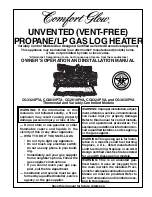
- 48 -
VENT PIPE INSTALLATION
Horizontal installation (See Fig. 5).
The horizontal termination (straight termination and L termination) consists of two parts (sleeve
and termination itself).
Separate them before installation.
1. Check the location of appliance and the path for the vent system.
2. Check wall thickness where the vent system passes through, and select suitable horizontal
termination according to TABLE 2. Cut the opening for the sleeve with the diameter in TABLE 2.
(Cover the flue outlet to avoid debris from entering the appliance)
3. Adjust the length of the sleeve so that the end of the sleeve protrudes about 0.2" (5mm) from
the wall. Then fasten the sleeve with the screw provided.
*Remember a stamped letter on the sleeve.
4. When the opening is too large, twist the packing provided around the end of the sleeve after
peeling off backing paper from the packing.
5. Insert the sleeve to the wall and fasten with 4 screws provided. Use plugs provided if needed.
*Ensure the UP label on sleeve plate is at the top.
*If it isn't easy to insert the sleeve because the packing doesn't fit the wall, press down the
packing during insertion.
6. Seal between the end of the sleeve and wall, and between the end of inner sleeve pipe and
outer pipe.
7. Adjust the length of the termination by fastening it at the stamped number same as that in 2.
8. Fasten the condensation prevention plate with the screw provided.
(In case of L termination or straight termination with reducer and elbow without additional straight
length, this plate must be installed.)
9. Insert the termination into the sleeve from inside wall so that 4 studs on sleeve plate are
inserted into each 4 holes on termination plate and fasten the termination to the sleeve with the
4 nuts provided.
*Ensure that the label on the termination is at the top.
10. Ensure that the end of air intake pipe protrudes about 0.4" (10mm) from the sleeve.
11. If using straight termination, connect reducer on appliance flue outlet, and 90º elbow between
reducer and termination.
If using L termination, connect reducer on appliance flue outlet and slide the adjustable part or
the termination to fit it to the flue outlet.
Make sure that a continuously DOWNWARD slope of no less than 2º (1/4 in/ft) is maintained
in the horizontal portion.
Refer to Fig 4-1 & 4-2 page 45.
12. Attach facing plate for outer wall as required.
*Drill 3 pilot holes in the outer wall first. Then insert plugs to the holes and fasten the facing plate
to the wall with 3 screws provided. Locate the notch of the facing plate at the bottom of the plate.
*Seal between the facing plate and the wall. Do not seal the notch.
TABLE 2 : Relationship between the range of wall thickness and the diameter of opening on the wall.
FFT-7U-200
FFT-7U-300
FFT-7U-500
FFT-7U(L)-200
FFT-7U(L)-300
FFT-7U(L)-500
ø5.7-5.9"
ø5.8-5.9"
ø6.1-6.9"
ø5.7-5.9"
ø5.8-5.9"
ø6.1-6.9"
3.9-9.8"
9.8-17.7"
17.7-25.6"
3.9-9.8"
9.8-17.7"
17.7-25.6"
Model Number
the diameter of opening
the range of wall thickness
(100-250mm)
(250-450mm)
(450-650mm)
(100-250mm)
(250-450mm)
(450-650mm)
(ø144-150mm)
(ø147-150mm)
(ø154-175mm)
(ø144-150mm)
(ø147-150mm)
(ø154-175mm)
*The diameter of the wall opening does not need to be increased if the wall opening is pitched
DOWNWARD towards the outside at a 2º (1/4 in/ft) pitch.
MPI P/N
3810
3811
3812
3813
3814
3815
Содержание MWH-180
Страница 60: ... 58 WIRING DIAGRAM ...
Страница 61: ... 59 WIRING DIAGRAM ...
















































